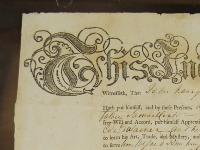Apprenticeship in the Eighteenth Century
Apprenticeship in the Eighteenth Century
Essential Questions
Objectives
- Students will be able to understand the significance of apprenticeships in the 18th century and their role as a source of education for some children.
- Students will be able to understand the role of children, parents, and masters in identifying, selecting, and engaging in an apprenticeship.
Primary Sources
Other Materials
Suggested Instructional Procedures
1. Introduction-
The night before the unit, assign students to read the Susan Klepp’s article in this issue of Legacies so that they had a basic understanding of apprenticeships.
2. Hook-
As a fun hook to this lesson, have the class watch a clip from Walt Disney’s Fantasia, The Sorcerer’s Apprentice. The first four animated minutes display the classic scene of Mickey working as an apprentice to use the magical powers from the sorcerer’s hat to make the mop clean on its own.
3. Quick interactive lecture- (5 to 10 min)
Teacher may begin by providing students with basic background information regarding apprenticeships in the 18th century. Give a brief lecture highlighting key points from Susan Klepp’s article.
4. Individual reading-
Download and photocopy the apprentice indentures and the indenture transcriptions. Distribute the photocopies to the students. Allow about 10 to 12 minutes for silent individual reading.
5. Class discussion- (25 min)
Come together as a class to check for understanding. Work together reading specific parts if necessary to interpret the 18th-century handwriting or explain particular phrasing. Begin class discussion by asking the students to brainstorm, identifying at least four characteristics of 18th-century apprenticeships. Write their suggestions (or have them write their own answers) on the board.
Key pieces to touch upon:
(a) Often begin at a young age
(b) Involve the learning of a craft or trade and the potential establishment of a career
(c) Are usually in the form of a contract (indenture) between apprentice and master, with a set time to serve
(d) Can be very restrictive and limiting for the apprentice
(e) Usually include master’s responsibility of room and board and sometimes even schooling and clothing for the apprentice
(f) Master acquires “free” labor for set period of time.
6. Group work/ Exit card Assessment -
Work in groups asking students to think about the parallels between the life of an apprentice and their own lives.
Each group will get an index card with a question from below. The group will work together to come up with a thorough answer. This should take around 10 minutes. Ask the group to formulate an answer to their particular question and write it on a piece of notebook paper. They must pass in their “exit card” as they leave the classroom.
(Teacher note: You may use the example questions below or make up your own. Make sure to ask questions about work, home life, and relationships with parents, teachers, and employers. )
Example questions:
- How has the role of parenting changed regarding expectations of providing room and board, an education, etc.?
- Where does an academic education fit into the life of students today in comparison to that of an 18th-century apprentice?
- What type of lifestyle today is most similar to that of an 18th century apprenticeship? How so?
- Are young people today more or less restricted in their choices than the apprentices of the past?
- How was a successful apprenticeship defined then? How is success defined today?
Vocabulary
- Apprentice: one who is learning by practical experience under skilled workers a trade, art, or calling
- Indenture: a contract binding one person to work for another for a given period of time
Plans in this Unit
Grade Level
Duration
Standards/Eligible Content
About the Author
This unit was created by Laura Beardsley. Modified and updated for SAS by Kimberly L. Parsons, Education Intern, and Historical Society of Pennsylvania.
Attention Teachers!
Let us know how you used this plan and be featured on our site! Submit your story here.


